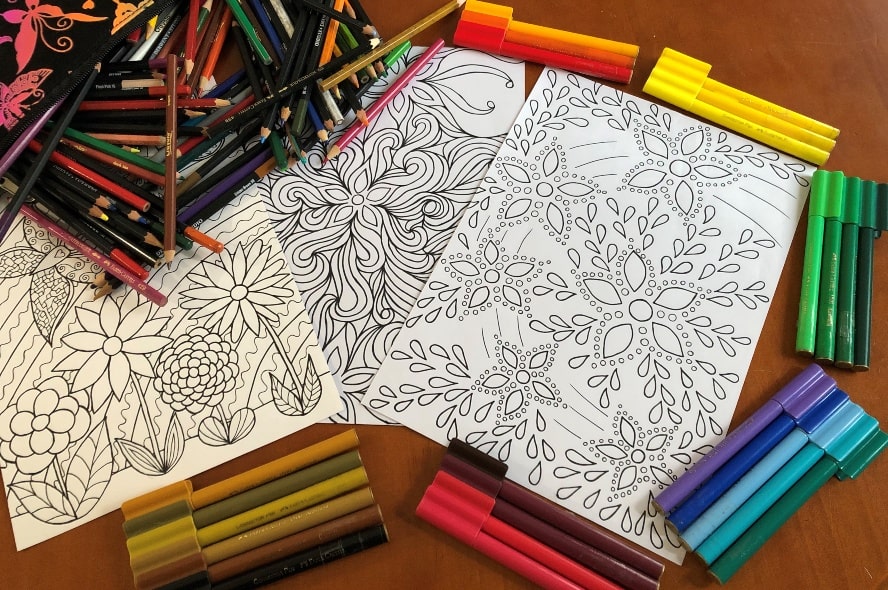In this post I’d like to share with you the five step process I found myself engaging in when paring down my crafty hobbies (and all the bits and pieces that can come with them!) to help you simplify your crafty hobbies.
Lately I’ve been re-organising my space, and it really feels like I’m re-organising my life. Every two months or so I find myself really invested in a YouTube channel, the creator and their content. Recently, I’ve been watching The Minimal Mom.
In a couple of videos I’ll link here, she talks about hobbies (with an emphasis on gardening), and how to declutter crafty hobbies.
When I put her suggestions into practice from these and other videos, I found that I followed a five step system that may help you as well to enjoy the hobbies that really light you up while letting go of others.
1) Identify what season of life you’re in right now
In another blog post called Cosy Minimalism, I came up with my own version of minimalism that allowed me to practice minimalist principles while still enjoying my crafty hobbies.
I mentioned that I have a variety of hobbies, and to get rid of a whole hobby and its related stuff because I wasn’t doing it in a particular ‘season’ of my life would be a disservice to me and my creativity because it’ll likely come back into season in the future.
A season of your life is basically what you’re doing, who you are and where you’re at in your current phase of life.
The season of life that I’m in is one of paring down with simplifying, getting focused and working on my health and business. I don’t have kids to think about, I live in a unit with my partner and elderly cat, and I’m a work from home writer. These things and others make up the season of life that I’m in.
A defining feature of this season for me is the yearning for simplicity, quiet, and deep calm.
Because I’m in this season of my life where I’m craving simplicity and spaciousness, I’ve changed my mind about being willing to hang on to the stuff that comes with hobbies (to be referred to as “hobby stuff” for the remainder of this post). From this season of life that I’m in, I want and need to pare down if I’m going to live simply.
Paring down books to just the ones I want to learn deeply from and read over and over again, my special books, has helped me enjoy them even more. I’ve always enjoyed reading, but limiting my options has expanded that enjoyment.
With this and other categories of items I’ve simplified (a term I prefer to decluttered), I found that even though I thought that having more things (in this case books) would mean more to enjoy (in this case reading), I found the opposite to be the case; by limiting my options through simplifying, I enjoyed and appreciated my things a whole lot more.
It’s sounds counter-intuitive and paradoxical, but it works.
With this in mind, I wondered, in this season of life that I’m in, would having less hobbies and less hobby stuff increase my enjoyment of the hobbies that really brought me consistent joy and those that I wanted to dedicate my precious spare time to?
I approached this with a “let’s find out” attitude.
2) Pay attention to what hobby you naturally gravitate towards and keep coming back to over and over again
After identifying the season of life I’m in, I did an honest assessment over time of all the hobbies that I had done and didn’t do anymore (but was still hanging on to the stuff!), the ones I still did but only occasionally, and the hobbies that I kept coming back to over and over again.
By starting with the crafty hobbies that I really really enjoyed and lit me up the most, I came up with knitting. Yep, that’s it. I find that I consistently come back to knitting every time; other hobbies may come and go through seasons, but I’m always knitting something.
Because I have other non-crafty hobbies that I’d like to dedicate my time to, like gardening, one crafty hobby for me to focus on is enough.
Then I focused on paring down those hobbies that I still enjoyed, but only did occasionally, but kept the stuff stashed away for ages.
I don’t know whether anyone else anthropomorphises inanimate objects, but that kind of neglect makes me uncomfortable. I’ll explore this more in step five.
With these occasional hobbies, I pared down massively on supplies, only keeping what I was actually going to use. This required a lot of honesty and being in a mood where I was willing to be ruthless with letting go, and where I was intentionally creating space in my life.
Not to mention creating time in my life! Taking part in hobbies takes time, and so I had to get really clear about what my time was worth to me, and what I would be willing to spend my precious time on.
Then I got to the hobbies that I did in one season of my life, but I no longer do, and while I was keeping the hobby stuff “just in case one day I decide to take it up again,” that one day wasn’t on the horizon. Time to get rid.
3) Recognise “aspirational items” or “ideal self” hobby clutter
A lot of the hobbies in the category of “did in one season of my life but don’t do anymore” are on a similar vein to “aspirational items” or “ideal self” clutter.
These are hobbies and stuff that you keep because you want to be perceived a certain way by others, or you hope to make it part of your identity one day. These are very future focused, and not focused on your current season of life. There’s a lot of hope in these things, but also a lot of potential overwhelm and pressure.
It’s like the classic example of all the active-wear and fitness equipment or yoga paraphernalia that you use once and then never touch again. You don’t like yoga and it doesn’t bring you any fulfilment, but you feel you should, it’s a mindful and calming form of exercise after all. Then once you have the yoga paraphernalia, you feel like you need to keep it because you spent money on it, it seems wasteful to get rid of it, and maybe one day in the future you’re going to wake up and think, “Gee, I absolutely love yoga! Shame I gave that stuff away.”
We need to be realistic about the likelihood that we’re ever going to have such a dramatic shift. I’d invite you to, while we’re getting rid of things here, to get rid of should from your vocabulary and life, and get rid of the things that make you say should.
Or with crafty hobbies, maybe you think you “should” knit, because your parent knitted and their grandmother before them and their mother before them and you have five aunts that all knit. So you get the yarn, and the needles, and before you know it you’ve got a drawer full of hobby stuff that doesn’t really bring you joy but instead just a whole bunch of shoulding (like the silent to-do list, which is a concept from Fumio Sasaki about how everything in your home is talking to you and telling you to do something. Like books are telling you to read them, dishes are telling you to use them or put them away or wash them at various times, and unfinished crafty hobby projects are telling you to finish them).

I did a face-painting course a decade ago. I’ve never done a kids’ party or even painted anyone’s face for fun (except my own a couple of times to practice). Yet I still had the empty ice-cream container, sponges, face paints and brushes stashed away “for later” because “I might do kids’ parties one day!” or “When I have kids it’ll be really handy to know how to face paint and have all the stuff!”
Be those things as they may, with the season of life that I’m in right now, kids aren’t on the radar, my own or anyone else’s. It’s been ten years since I did that course so if I haven’t face-painted already, I doubt I’m going to. I’ve been hanging onto these paints for a decade with minimal use, and I know I paid money for them, but hanging on to items isn’t going to bring my money back. And looking at the paints they looked dodgy as so I had to chuck them.
I figure, I’m not a wasteful person, I’m a more conscious consumer now than ever, so in this case, I’m content with the fact that no one can get any use from these (and hygiene is important), so I chucked the paints with the knowledge that if it turns out that I do really want to face-paint in another season of my life (probably the one that has kids in it) then I can buy some more.
Let go of these items and live in the now season, and see how your enjoyment of your truly enjoyable activities increases.
4) Give yourself permission to let things go
The feeling of spaciousness and an increase of enjoyment in hobbies that you’ve decided to keep may come after an initial period of, “Oh my god, what have I done? What if I need that stuff?!”
Lean into it and let stuff go anyway. A lot of this I think comes down to giving ourselves the permission to let things go. We may have been brought up with a scarcity mindset, encouraged to hold onto things lest disaster strike, or thinking we need to keep things to keep memories. These beliefs can keep us hanging in to things that don’t serve us, not just tangible items, but behaviours and habits too.
The thing is, you can create a box that you keep somewhere, that The Minimal Mom calls the “time will tell” box or the “quarantine box”. This is for those of us who really struggle with the beliefs mentioned above and giving away ‘our’ things.
Before I had a better name for it, I called this box and area in my garage the “requires further consideration” box/area. Let’s go with quarantine box for now.
The quarantine box serves as a temporary place to “give away” your items without really giving them away (yet). This has been so valuable for me, and takes the pressure off immensely. Of course I outright declutter where I feel I can (and maybe slightly beyond), because I know from personal experience that I feel better every time.
But for someone beginning, this box is a good way to start. It’s like a trial of sorts to see if you miss the hobby stuff. Give yourself a set time, maybe six months to a year (probably no more than that), and if you haven’t reached for it or sought it out, then it can go.
It’s risk free and a great beginner strategy.

5) Think about others
The last step in my recent simplifying process is to think about others. Throwing things out is sometimes an unfortunate and difficult thing to do but necessary (and there’s no need to feel guilty about it if it comes to that).
But when it’s stuff that someone else could benefit from, it feels selfish to keep that sat in a drawer somewhere when someone else could be using it!
When I’m faced with the “to keep or to give away” conundrum with something I’m sitting on the fence about, the deciding factor is usually that someone else could do a whole lot more with this than I could right now.
It also taps into what I mentioned earlier about anthropomorphising things – having things sitting unused in a drawer doesn’t make me feel good. It makes me feel neglectful.
I’d much rather some kid who doesn’t have much except untapped artistic talent be using my paints than them be drying up neglected in a drawer somewhere.
As my partner pointed out the other day, “You can’t take stuff with you.” When we die, he means. And he’s right. Not to be morbid but that could happen at any time. Hopefully not for a while, but if it should happen suddenly, I really don’t want people to be left going through my stuff that I didn’t deal with.
Final Thoughts
I hope this has helped you simplify your crafty hobbies and with potentially paring them down!
Let me know if you use this method, or if you have a method of your own that helps. By writing a comment below you’ll be helping me out and helping others out who also want tips to simplify by decluttering crafty hobbies.
You can also reach out to me at [email protected] any time.
Happy simplifying!

P.S. For extra content, updates and other good stuff, you’re warmly invited to join The Quiet and Curious folk community by signing up to the email newsletter below:



